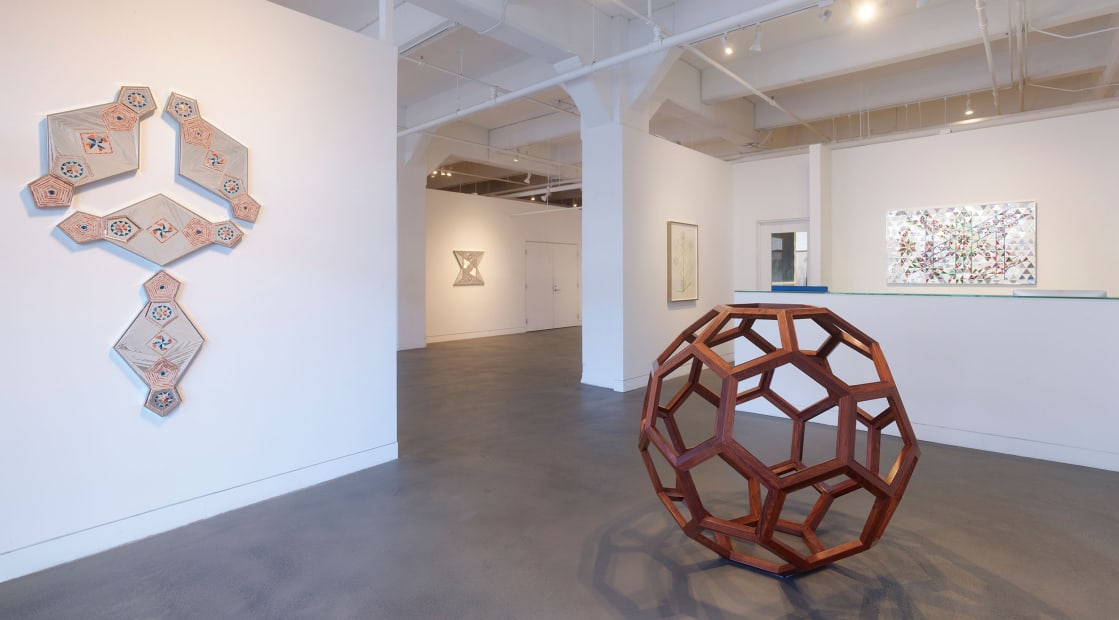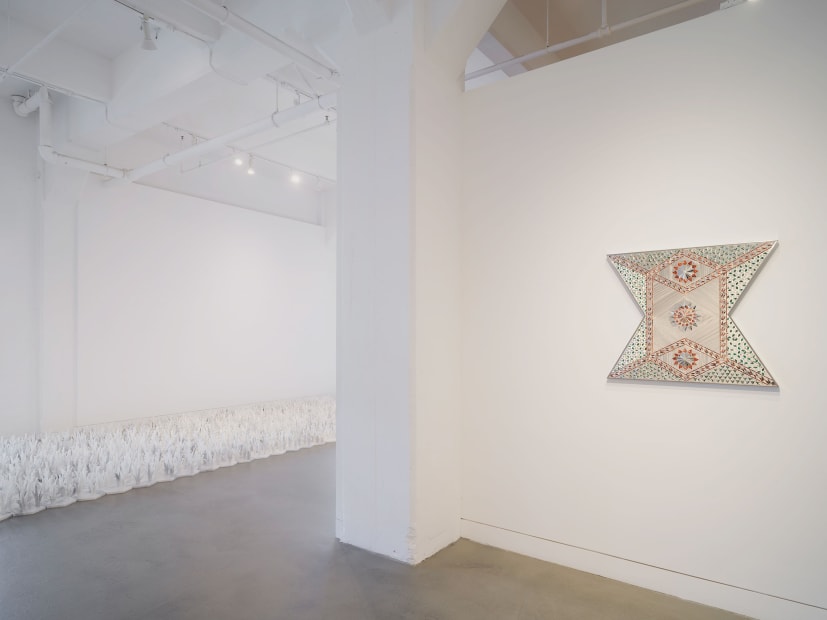Ai Weiwei and Monir Shahroudy Farmanfarmaian:
Sacred and Profane Geometries
Past exhibition
Overview
Haines Gallery proudly presents Sacred and Profane Geometries, two solo exhibitions by artists Ai Weiwei and Monir Shahroudy Farmanfarmaian.
Shaped by experiences of diaspora and exile and informed by exposure to New York’s art scene early in their creative development, both Ai and Monir are well-known for fusing the traditional methods and materials of their native countries — China and Iran, respectively — with the impulses of abstraction and conceptual art. Marking the first time the works of these important artists have been placed in dialogue, these tandem exhibitions bring together cultural references specific to each, while focusing on their shared use of geometrical forms to explore concerns that range from the political to the mystical.
At the center of Ai Weiwei’s presentation is Cao (2014), a monumental installation representing thousands of grass blades on a network of hexagonal bases, each of its over 500 individual components hand-carved from gleaming white marble. “Cao/草” means “grass” in Mandarin, and can also be used to refer to the ordinary populace (草根, literally “grass roots”); with a shift in intonation, the word can also become an expletive (one typically followed by “your mother”). Such coded language is popular with Chinese netizens, an ingenious way to speak freely and critically in the face of heavy censorship, and a recurring element in Ai’s multi-disciplinary practice. Cao highlights the strength and value of an individual in the face of authoritarian regimes, playing on the values associated with grass across multiple cultures, while its tiled geometric component — modular, expansive, with the potential for infinite growth — illustrates the power of the collective and of grassroots political movements. Here, marble’s suggestion of nobility is focused not on a single, heroic individual, but on manifold, anonymous blades of grass.
These geometric and natural forms are complemented by Divina Proportione (2010), a wooden sculpture with 20 hexagonal and 12 pentagonal faces. In form, the work recalls Leonardo da Vinci’s illustrations for Luca Pacioli’s De Divina Proportione, a seminal mathematical text on geometry in art and architecture. Elsewhere, Ai has cited a much more quotidian inspiration: a plastic cat toy. Created without the use of nails and screws using joinery techniques perfected during the Ming Dynasty, Divina Proportione is at once a study of harmonious proportion, an invocation of Renaissance-era humanism, a reinterpretation of traditional Chinese craftsmanship, and a monument to the everyday.
Ai’s sculptures are presented in dialogue with an exhibition of Monir Shahroudy Farmanfarmaian’s signature mirrored mosaics, drawings, and mixed-media works. As with Ai’s wood and marble sculptures, Monir’s mirrored works are rooted in geometry — a tool for invention the artist used to produce infinite variation in form and patterning. This exhibition includes stunning examples of these prismatic, wall-hung sculptures: Gabbeh (2009), a composition of colorful polygons, arcs and diagonals, and a work from her Convertible series (2016), a jewel-like, multipart relief composed of geometric elements that can be arranged in a striking variety of configurations. Nearly all of these works are being presented in the United States for the first time.
Monir’s practice synthesizes 20th century abstraction with the tenets of Sufi geometry, Islamic architecture and ornamentation, and the vernacular craft traditions of Iran. In the decades before the 1979 Islamic Revolution, the artist traveled throughout the country, visiting villages and nomadic communities to learn about their visual heritage and material cultures. Throughout her career, she would translate (and sometimes incorporate) these forms and materials into her work. Gabbeh references, in name and motif, a type of woven rug from Iran’s Zagros mountains, typically woven by women; Kashi (2019) incorporates shards of lustreware pottery for which the work is named.
Also included in the exhibition is Nomadic Tent (1977), a sculptural collage of cut and folded paper. Overlapping triangles and floral cut-outs reveal colorful Farsi calligraphy rendered in Monir’s hand. An abstract interpretation of the Siah-Chadors (“black tents”) that are an architectural form used by many of Iran’s tribal peoples, the work is both prescient and timely, full of symbolic meaning about chadors and the bodies that inhabit them. With its implication of movement and impermanence, the tent’s form foreshadows Monir’s eventual loss of a home and her life as an immigrant in New York, where she and her family resided for over twenty years following the Islamic Revolution.
A chador is also a type of hijab, its form serving as the source of Monir’s inspiration for a series of eponymous, colorful drawings made by the artist during the 1970s. Today, these evocative works on paper take on renewed significance, evoking the ongoing fight for women’s rights and autonomy in an oppressive, patriarchal regime. Since 1979, women in Iran have been harassed, sanctioned, imprisoned, and even executed by the state around its mandatory hijab laws. On September 16, 2022, a 22 year-old woman named Mahsa Amini died in police custody after being detained by the Morality Police for her “improper” hijab. Her death — and the death of hundreds of protestors killed in subsequent days — has sparked a movement across Iran and the Iranian diaspora that reached a revolutionary scale.
In its origins, the word “geometry” means “to measure the earth.” But in many cultural traditions, geometry is less about measuring the earth than about identifying, within the earthly realm, manifestations of a natural or divine order. These two exhibitions highlight geometry — both sacred and agnostic — within the work of two celebrated artists, ultimately emphasizing how its beauty might serve as a source of shared strength and unity.
Exhibition Views
Selected Works














